The Hygric Behaviour of Historic and Newly Fabricated Lime-Based Mortars, Renders and Plasters
Abstract
1. Introduction
2. Materials and Methodology
2.1. Materials
2.2. Laboratory Testing
2.3. Hygrothermal Modelling
3. Results
3.1. Bulk Density and Open Porosity
3.2. Sorption Capacity
3.3. Capillary Absorption
3.4. Vapour Diffusion Resistance
4. Discussion and Hygrothermal Modelling
5. Conclusions
Author Contributions
Funding
Institutional Review Board Statement
Informed Consent Statement
Data Availability Statement
Acknowledgments
Conflicts of Interest
References
- Banfill, P.F.G. Hygrothermal Simulation of Building Performance: Data for Scottish Masonry Materials. Mater. Struct. 2021, 54, 167. [Google Scholar] [CrossRef]
- Torney, C.; Snow, J. Lime Mortars in Traditional Buildings: Short Guide 6; Technical Report; Historic Environment: Edinburgh, Scotland, 2014; Available online: https://www.researchgate.net/publication/264563855 (accessed on 27 August 2025).
- Pavía, S.; Bolton, J. Stone, Brick and Mortar: Historical Use, Decay and Conservation of Building Materials in Ireland; Wordwell: Bray, Co.: Wicklow, Ireland, 1999; ISBN 9781869857325. [Google Scholar]
- Hughes, J.J.; Cuthbert, S.J. The Petrography and Microstructure of Medieval Lime Mortars from the West of Scotland: Implications for the Formulation of Repair and Replacement Mortars. Mater. Struct. 2000, 33, 594–600. [Google Scholar] [CrossRef]
- Bartz, W.; Rogóż, J.; Rogal, R.; Cupa, A.; Szroeder, P. Characterization of Historical Lime Plasters by Combined Non-Destructive and Destructive Tests: The Case of the Sgraffito in Bożnów (SW Poland). Constr. Build. Mater. 2012, 30, 439–446. [Google Scholar] [CrossRef]
- Groot, C.J.W.P.; Ashall, G.J.; Hughes, J.J.; Bartos, P.J.M. Characterisation of Old Mortars with Respect to Their Repair: A State of the Art. In Characterisation of Old Mortars with Respect to Their Repair; RILEM Publications SARL: Bagneux, France, 2007; Chapter 1; pp. 1–8. [Google Scholar]
- Schueremans, L.; Cizer, Ö.; Janssens, E.; Serré, G.; Van Balen, K. Characterization of Repair Mortars for the Assessment of Their Compatibility in Restoration Projects: Research and Practice. Constr. Build. Mater. 2011, 25, 4338–4350. [Google Scholar] [CrossRef]
- Kurugöl, S.; Güleç, A. Physico-Chemical, Petrographic, and Mechanical Characteristics of Lime Mortars in Historic Yoros Castle (Turkey). Int. J. Archit. Herit. 2011, 6, 322–341. [Google Scholar] [CrossRef]
- Misiewicz, J.; Kwiatkowska, L.; Ballai, G. Investigation of Mortars from Historical Monuments of North-East Poland and Assessment of Compatibility between Historic and Restoration Mortars. Constr. Build. Mater. 2025, 474, 141075. [Google Scholar] [CrossRef]
- Copsey, N. Historic Literature Review of Traditional Lime Mortars: Excerpts from Historic Texts 160 BC—1955; Historic Environment: Edinburgh, Scotland, 2019. [Google Scholar]
- Pavía, S.; Veiga, R.; Hughes, J.; Pesce, G.; Valek, J.; Alvarez, J.I.; Faria, P.; Padovnik, A. RILEM TC 277-LHS Report: How Hot Are Hot-Lime-Mixed Mortars? A Review. Mater. Struct. 2023, 56, 87. [Google Scholar] [CrossRef]
- Margalha, M.G.L.B.; Veiga, M.D.R.; Santos Silva, A.; de Brito, J. Traditional Methods of Mortar Preparation: The Hot Lime Mix Method. Cem. Concr. Compos. 2011, 33, 796–804. [Google Scholar] [CrossRef]
- Walker, R.; Hofheinz, A.; Engel Purcell, C.; Kinnane, O. The Hygrothermal Properties and Behaviour of Historic Mortars, Plasters and Renders. Constr. Build. Mater. 2025, in press. [Google Scholar]
- EN1936:2006; Natural Stone Test Methods—Determination of Real Density and Apparent Density, and of Total and Open Porosity. iTeh, Inc.: Newark, DE, USA, 2006.
- ISO 12570:2000; Hygrothermal Performance of Building Materials and Products—Determination of Moisture Content by Drying at Elevated Temperature. ISO: Geneva, Switzerland, 2000.
- ISO 12571:2021; Hygrothermal Performance of Building Materials and Products—Determination of Hygroscopic Sorption Properties. ISO: Geneva, Switzerland, 2021.
- EN 13755:2008; Natural Stone Test Methods—Determination of Water Absorption at Atmospheric Pressure. iTeh, Inc.: Newark, DE, USA, 2008.
- ISO 15148:2002; Hygrothermal Performance of Building Materials and Products—Determination of Water Absorption Coefficient by Partial Immersion. ISO: Geneva, Switzerland, 2002.
- ISO 12572:2016; Hygrothermal Performance of Building Materials and Products—Determination of Water Vapour Transmission Properties—Cup Method. ISO: Geneva, Switzerland, 2016.
- Hofheinz, A.; Walker, R.; Engel Purcell, C.; Kinnane, O. The Hygrothermal Properties of Historic Bricks: Case Study of Traditional Brick Construction Material in Ireland. Build. Environ. 2025, 270, 112491. [Google Scholar] [CrossRef]
- Hofheinz, A.; Walker, R.; Engel Purcell, C.; Kinnane, O. The Hygrothermal Properties of Stone Used in Traditional Construction: A Western European Case Study. Build. Environ. 2025, 276, 112855. [Google Scholar] [CrossRef]
- Arrizzi, A.; Cultrone, G. The Water Transfer Properties and Drying Shrinkage of Aerial Lime-Based Mortars: An Assessment of Their Quality as Repair Rendering Materials. Environ. Earth Sci. 2014, 71, 1699–1710. [Google Scholar] [CrossRef]
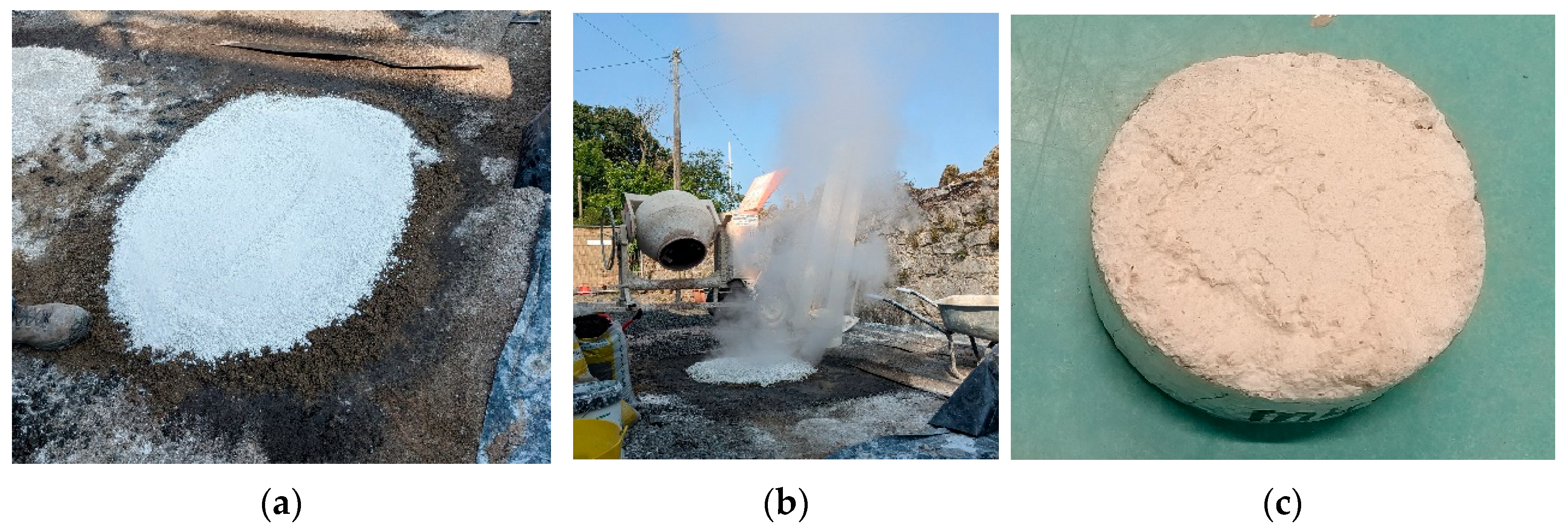


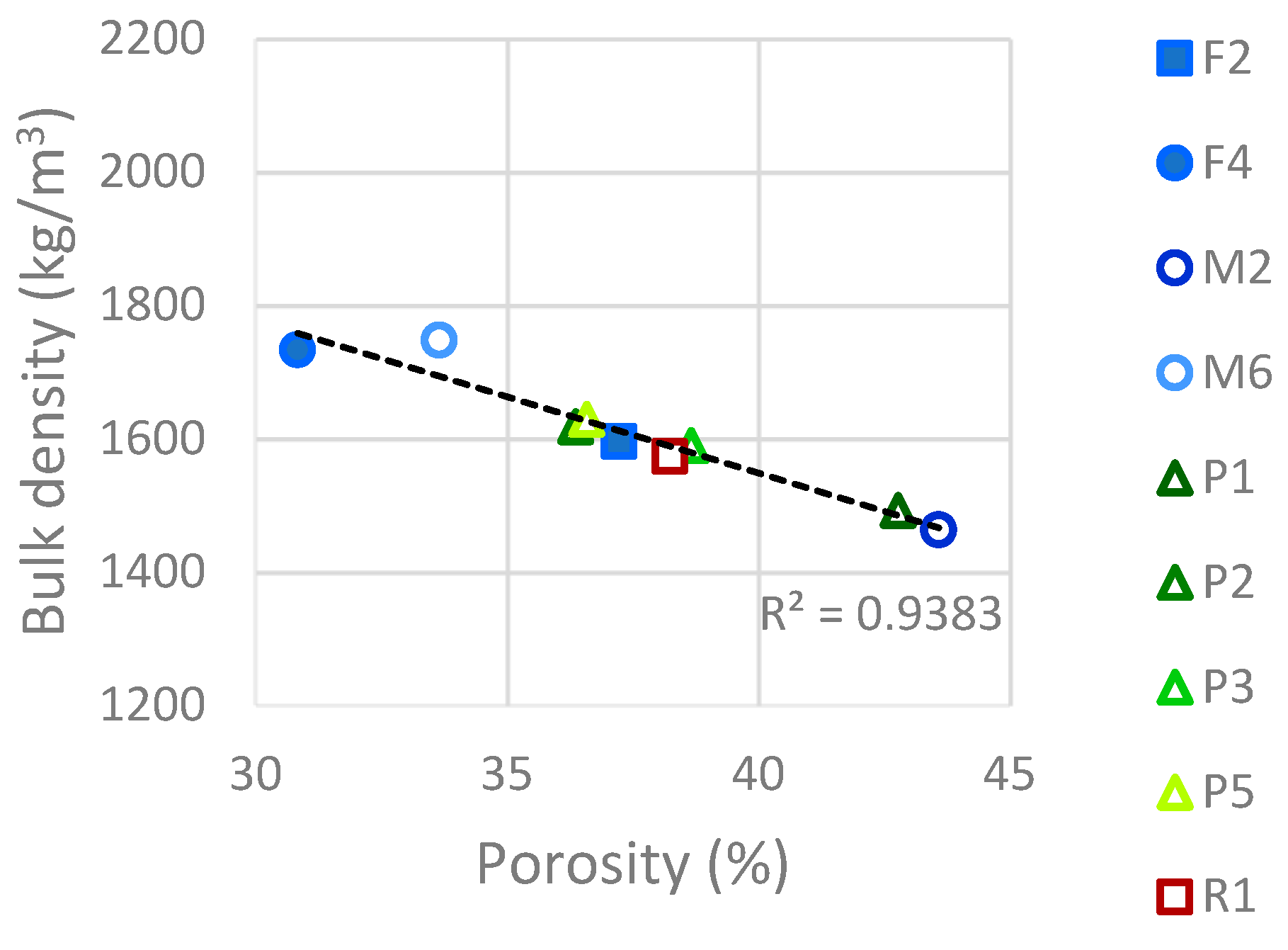

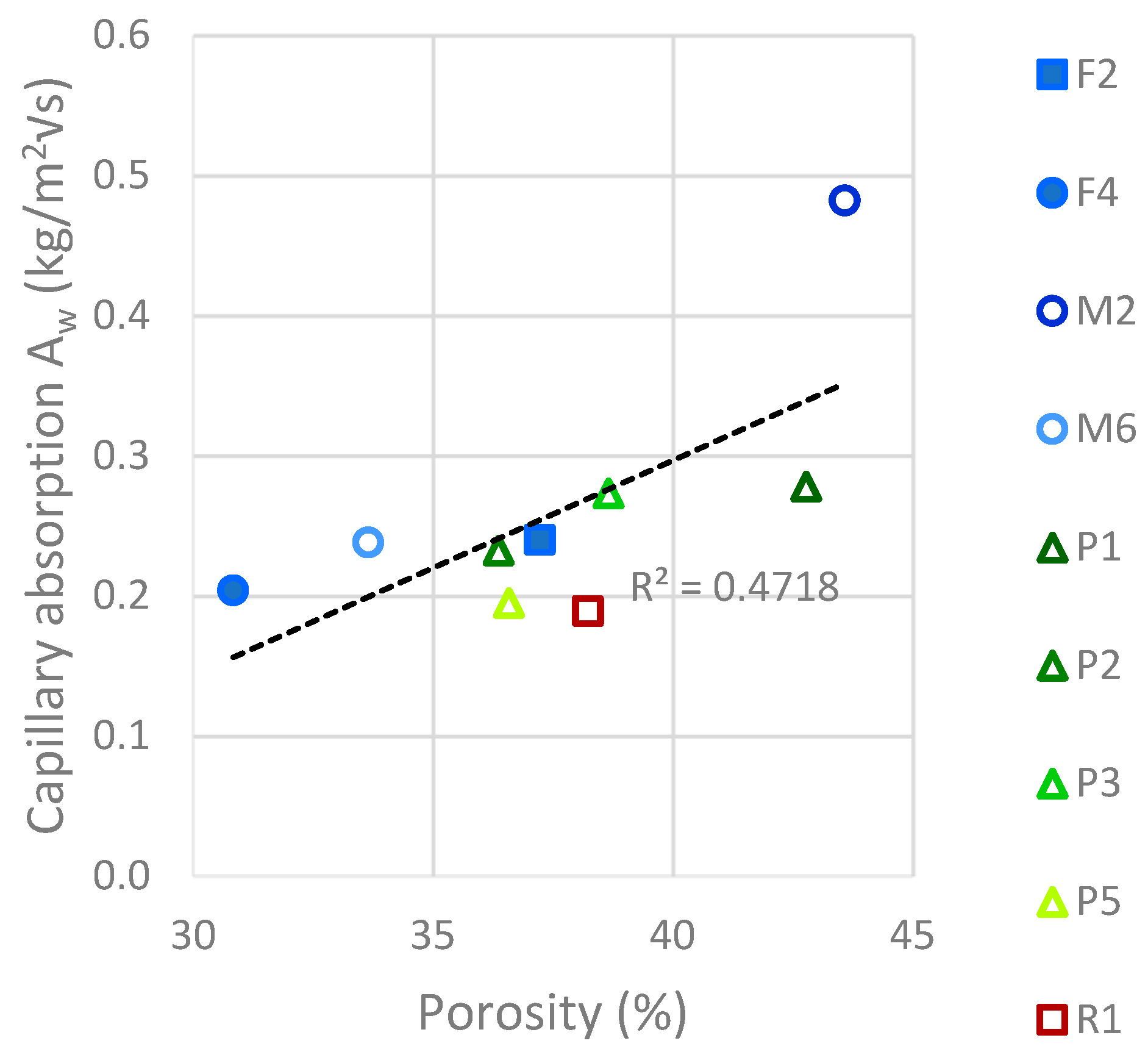
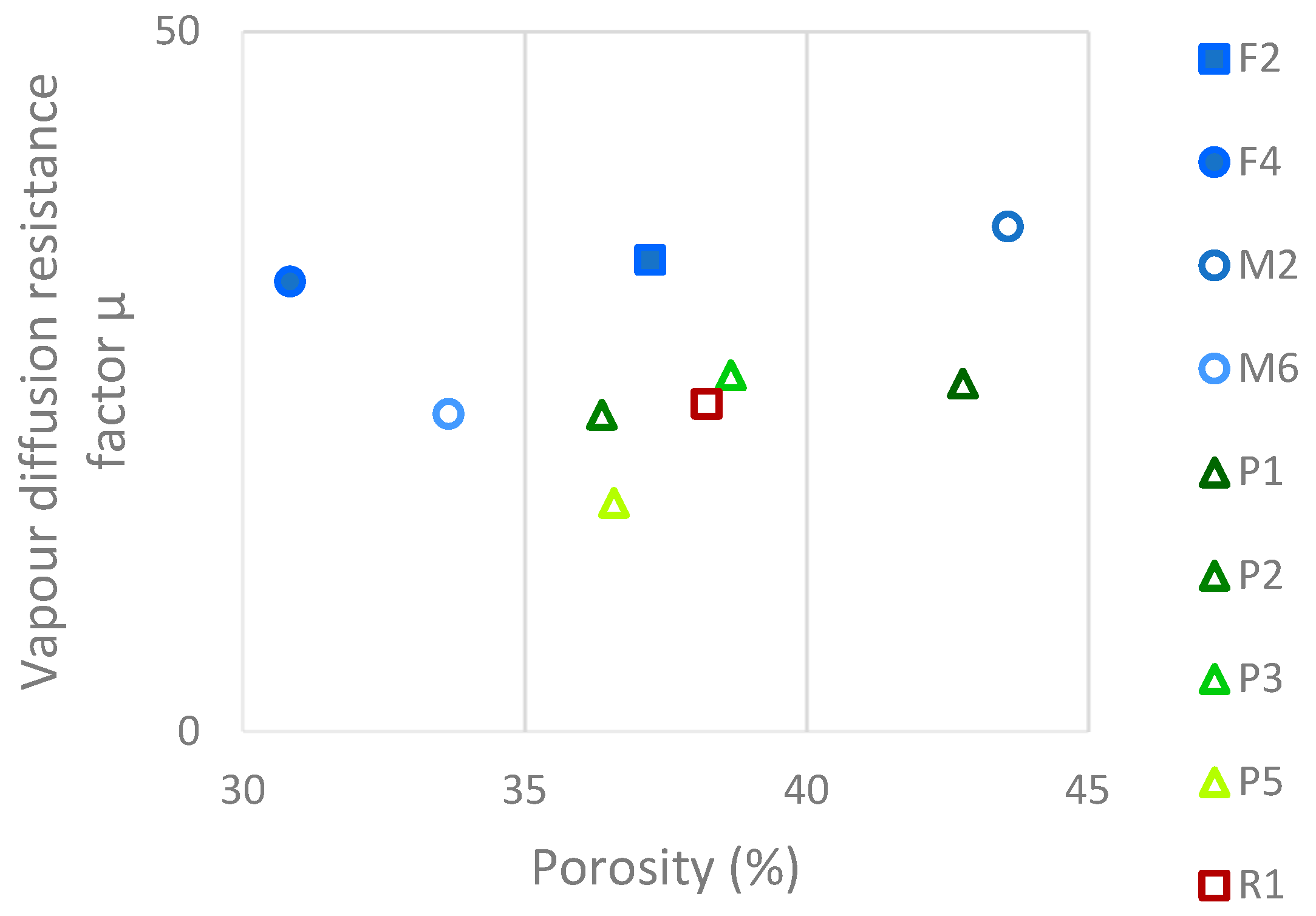
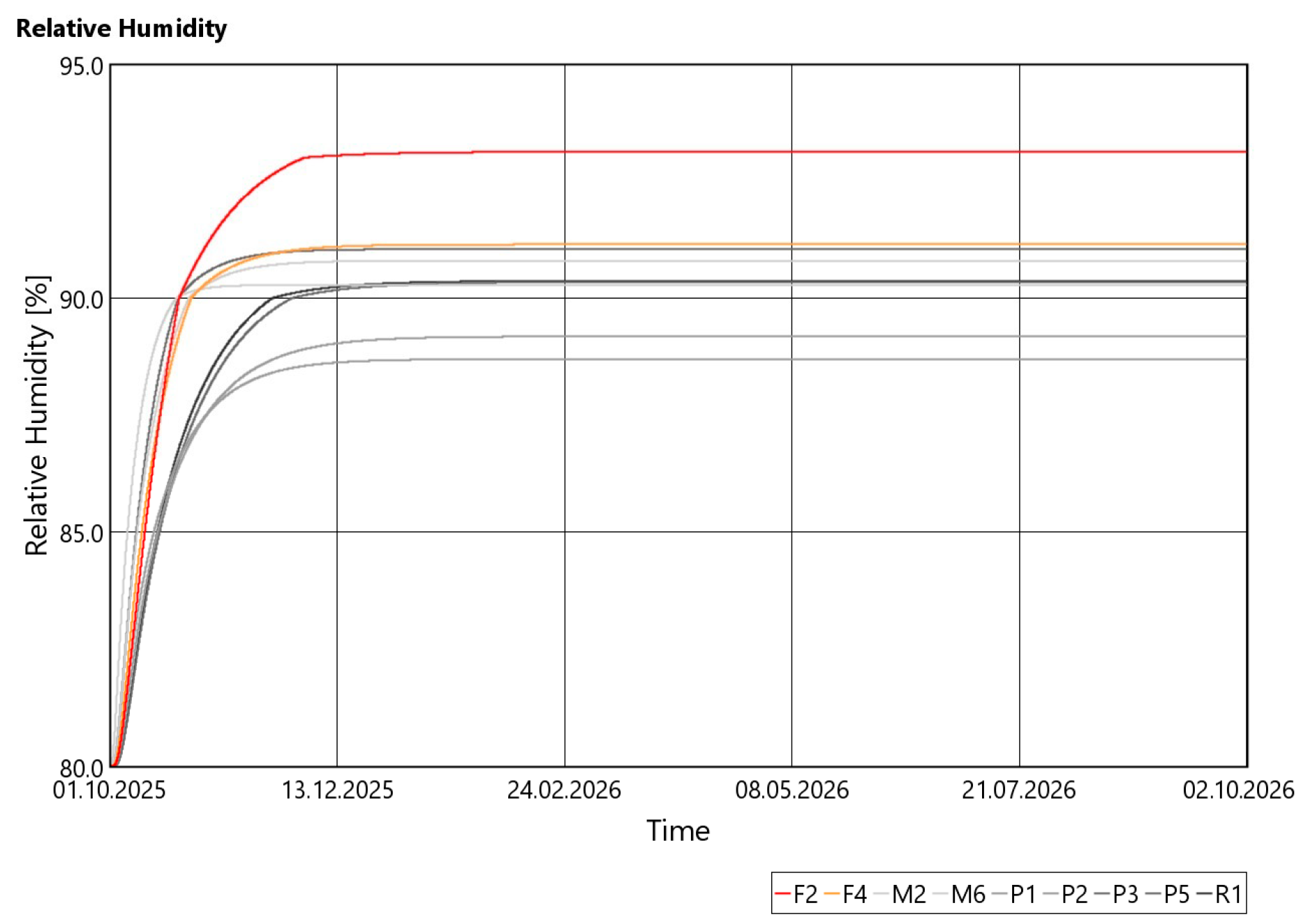



| Name | Description | Approximate Date |
|---|---|---|
| F2 | Fabricated mortar 1:2 | 2023 |
| F4 | Fabricated mortar 1:4 | 2023 |
| M2 | Lime-based mortar from rubble granite wall | c. 1740s |
| M6 | Lime-based mortar from brick wall (rear elevation) | c. 1870s |
| P1 | Lime-based internal plaster from Georgian townhouse | c. 1800s |
| P2 | Lime-based internal plaster (lath and plaster—lath not included in test) | c. 1850s |
| P3 | Lime-based internal plaster | c. 1850s |
| P5 | Lime-based internal plaster | c. 1890s |
| R1 | Lime-based external render from stone outbuilding | c. 1800s |
| Test | Standard | Summary of Test Procedure |
|---|---|---|
| Open porosity/bulk density | EN 1936:2006 [14] ISO 12570:2000 [15] | Saturation of samples in water under a vacuum; calculation of density and porosity from wet weight (submerged), wet weight (dabbed), and dry weight * Irregular shaped samples were used, and some loss of material resulted during saturation in water |
| Moisture adsorption | ISO 12571:2021 [16] | Fractured samples conditioned to a constant weight at 50%, 80%, and 95 and/or 97% RH; calculation of moisture content in kg/kg (%) * No change from the standard |
| Free saturation | EN 13755:2008 [17] | Saturation of samples in water at atmospheric pressure; calculation of water content at 72 h * Irregular shaped samples were used, and some loss of material during saturation in water |
| Capillary absorption | ISO 15148:2002 [18] | Partial immersion of samples in water (1 contact face); calculation of rate of absorption over time from repeated weighing * The samples had irregular cross-section areas. Samples were suspended over water |
| Vapour permeability | ISO 12572:2016 [19] | Samples on dry cups conditioned at 50% RH/23 °C; calculation of vapour diffusion resistance from average weight gain after stabilization period * The samples had small and irregular cross-section areas |
| Material | ρ | ϕ | w80 | wf | Aw | μ | λdry |
|---|---|---|---|---|---|---|---|
| kg/m3 | % | kg/m3 | kg/m3 | kg/m2√s | - | W/mK | |
| M2 | 1463.42 | 43.6 | 16.21 | 369.06 | 0.482 | 36.04 | 0.46 |
| CV (%) | 1.5 | 2.7 | 11.7 | 3.0 | 6.6 | 16.3 | 15.7 |
| M6 | 1747.72 | 33.7 | 19.84 | 270.10 | 0.238 | 22.65 | 0.91 |
| CV (%) | 1.1 | 1.5 | 50.5 | 2.6 | 16.3 | 17.4 | 7.3 |
| P1 | 1492.27 | 42.8 | 16.97 | 370.18 | 0.278 | 24.86 | 0.48 |
| CV (%) | 1.6 | 1.6 | 9.0 | 2.3 | 24.8 | 28.4 | 14.6 |
| P2 | 1617.93 | 36.4 | 11.12 | 326.47 | 0.232 | 22.61 | 0.31 |
| CV (%) | 2.2 | 6.0 | 4.2 | 3.2 | 21.7 | 11.0 | 21.7 |
| P3 | 1589.68 | 38.7 | 9.91 | 288.28 | 0.273 | 25.44 | 0.60 |
| CV (%) | 2.0 | 3.6 | 18.8 | 4.1 | 10.2 | 17.6 | 2.2 |
| P5 | 1628.89 | 36.6 | 13.48 | 302.34 | 0.195 | 16.33 | 0.62 |
| CV (%) | 1.4 | 2.5 | 16.7 | 2.6 | 29.2 | 18.7 | 7.2 |
| R1 | 1573.24 | 38.2 | 25.01 | 319.23 | 0.189 | 23.39 | 0.41 |
| CV (%) | 1.8 | 3.8 | 5.7 | 3.1 | 30.2 | 27.5 | 16.6 |
| F2 | 1595.59 | 37.2 | 19.81 | 318.65 | 0.240 | 33.65 | 0.84 |
| CV (%) | 0.8 | 1.4 | 53.2 | 1.2 | 3.6 | 20.2 | 6.9 |
| F4 | 1733.05 | 30.8 | 11.35 | 253.98 | 0.204 | 32.11 | 0.95 |
| CV (%) | 0.5 | 3.7 | 10.9 | 0.5 | 4.2 | 6.5 | 4.7 |
Disclaimer/Publisher’s Note: The statements, opinions and data contained in all publications are solely those of the individual author(s) and contributor(s) and not of MDPI and/or the editor(s). MDPI and/or the editor(s) disclaim responsibility for any injury to people or property resulting from any ideas, methods, instructions or products referred to in the content. |
© 2025 by the authors. Licensee MDPI, Basel, Switzerland. This article is an open access article distributed under the terms and conditions of the Creative Commons Attribution (CC BY) license (https://creativecommons.org/licenses/by/4.0/).
Share and Cite
Walker, R.; Hofheinz, A.; Purcell, C.E.; Kinnane, O. The Hygric Behaviour of Historic and Newly Fabricated Lime-Based Mortars, Renders and Plasters. Architecture 2025, 5, 99. https://doi.org/10.3390/architecture5040099
Walker R, Hofheinz A, Purcell CE, Kinnane O. The Hygric Behaviour of Historic and Newly Fabricated Lime-Based Mortars, Renders and Plasters. Architecture. 2025; 5(4):99. https://doi.org/10.3390/architecture5040099
Chicago/Turabian StyleWalker, Rosanne, Anna Hofheinz, Caroline Engel Purcell, and Oliver Kinnane. 2025. "The Hygric Behaviour of Historic and Newly Fabricated Lime-Based Mortars, Renders and Plasters" Architecture 5, no. 4: 99. https://doi.org/10.3390/architecture5040099
APA StyleWalker, R., Hofheinz, A., Purcell, C. E., & Kinnane, O. (2025). The Hygric Behaviour of Historic and Newly Fabricated Lime-Based Mortars, Renders and Plasters. Architecture, 5(4), 99. https://doi.org/10.3390/architecture5040099







